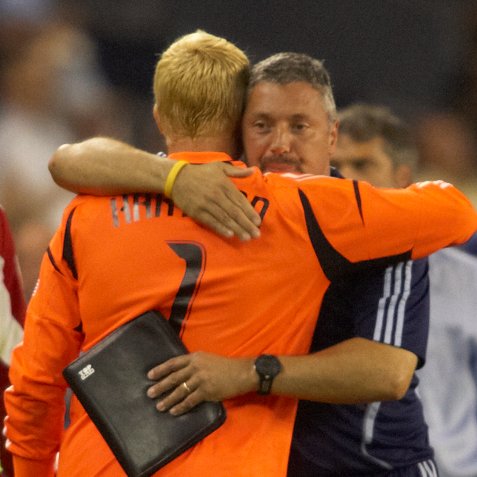
Kyle Unitas
@kyleunitas
Followers
134
Following
3K
Media
7
Statuses
383
Observer of how 🏒 players move, compensate, and reorganize. Developer of reformed powerskating and movement made for the game.
Powerville, ON
Joined September 2022
Through a practical lens, mechanical efficiency is probably best understood as a bandwidth—rather than a single razor-thin target. Within that range, athletes can still move effectively, sustainably, and safely without always hitting the singular “most efficient” form.
@kyleunitas I think this is a great question. But is there a bandwidth around mechanical efficiency? While I accept that there is only one MOST efficient solution, would you consider solutions that are mechanically efficient “enough”, that are not (potentially) injurious?
2
1
4
💭 If gamification reinforces any successful solution, how do we ensure it’s reinforcing the most mechanically efficient one—rather than just the one that works to achieve any given game’s intended outcome?
1
0
7
This is a superb and nuanced point that gets to the very core .. distinguishing between functional stability [robustness] and rigid stability [brittleness] is the central theme .. ⚾️
@10Simmer10 @kyledupic Worth noting that stability ≠ rigidity. Stability can mean having reliable mechanics and attractors that are sustainable under fatigue, response speed, body contact (is this an element of consideration in Dupic’s ⚾?) and unpredictability of the game. That’s a part of what
0
1
3
The Need for Repetition: 2 groove efficient, stable, and powerful movement patterns [attractors] The Need 4 Variation: 2 prevent stagnation, build resilience, and develop the adaptive capacity 2 handle any situation the sport presents..🖖🏼⚽️
Training weeks must have a certain pattern & rhythm. There needs to be an alternation in the focus between big & small spaces. Between macro & micro concepts. Between focusing on aerobic & anaerobic systems. In short, there must be a methodology & alternation in Specificity
1
1
1
ED discourse rarely gives back as much as it asks of you. It demands patience with abstract framings but resists offering clarity, testability, or practical payoff in return. In a coaching world where your time is already taxed, that’s not a good trade.
0
0
1
Instead of clarity, you get deflection; instead of traction, you get vagueness. That’s the deeper “can’t be bothered” reason—if the exchange doesn’t feel reciprocal, you naturally move on.
1
0
0
Coaching is indeed a reciprocal system: you invest because you get something back (progress, clarity, joy, outcomes). ED conversations often don’t provide that return.
1
0
0
That rhetorical retreat makes it feel like a stacked deck. If you can never pin down what it is—tool, framework, or grand theory—it’s exhausting to even try.
1
0
0
When you point out shortcomings (lack of validation, logical contradictions, repackaging old insights), you often get the same response: “That’s a misunderstanding, ED is a worldview not a tool.”
1
0
0
@JordanGush makes a great point here re: language. https://t.co/hPOCZHTpMp
Sport coaches and athletes have no clue what the hell affordances, constraints, non-linear pedagogy, etc., etc., mean. The language does not resonate. I was listening to a podcast and this came up... They say people need to adapt to the language… lol, that movement will move
1
1
0
When an idea never bridges into actionable methods—or worse, is treated as if actionable methods are “missing the point”—it stops being worth your time.
1
0
0
For someone in the trenches of coaching, what matters is what to do. Theories of perception-action or environments of affordances don’t tell you how to help a kid fix a stride or stabilize a habit under fatigue.
1
0
0
That combo makes it slippery and unrewarding to engage with. You can’t get traction because it’s insulated against both falsification and application.
1
0
0
When someone says “ED doesn’t do anything, it’s just a way of looking at the world” they simultaneously claim it’s not a tool (so you can’t critique it) and that it explains everything (so you can’t ignore it).
1
0
0
There are a few overlapping reasons why “coaches can’t be bothered” with the way ED is often framed in discussions like this. Let’s unpack it.🧵
I agree with this strongly. Ecological Dynamicsis a field of study and a way of looking at the world, movement and learning. It’s not a coaching tool, and it shows bizarre levels of misunderstanding to suggest it is. The constraints led approach emerged from EcoD. It could be
1
0
4
The 🚗 analogy erases that loop, reinforcing the false belief that cones or isolated work are inherently sterile, when in truth they’re the anchors that make transfer into chaos reliable.
0
0
1
Instead, effective development lives in the iterative loop: stabilize → stress-test → reorganize → repeat.
1
0
2
So what this analogy really reveals is a misunderstanding: constraints aren’t invalid if they don’t look like the full game, isolation isn’t the absence of constraints, and chaos doesn’t automatically build robustness.
1
0
1











